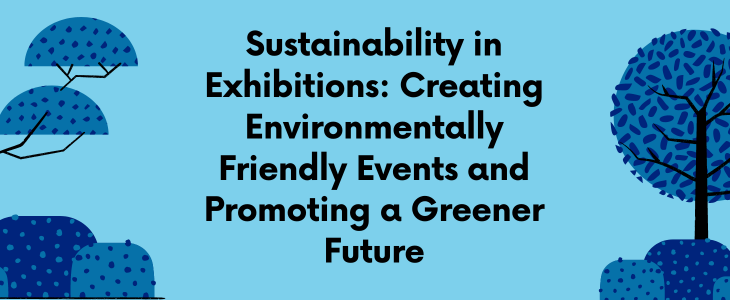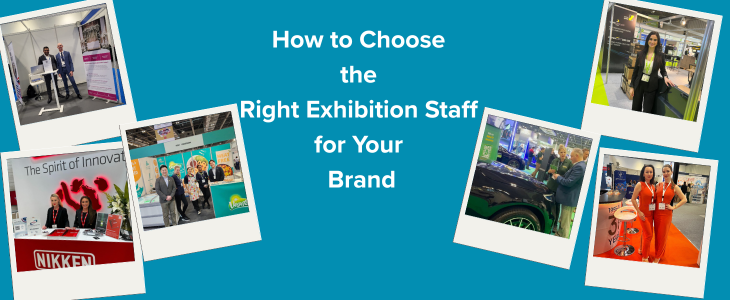Not Getting the Right Visitors? How Exhibition Staff Can Target Your Ideal Audience Exhibiting at…

Sustainability in Exhibitions: Creating Environmentally Friendly Events and Promoting a Greener Future
Sustainability in Exhibitions: Creating Environmentally Friendly Events and Promoting a Greener Future
As the world becomes increasingly aware of environmental issues, the exhibition industry is stepping up to embrace sustainability. Creating environmentally friendly exhibitions not only benefits the planet but also resonates with attendees who value eco-conscious practices. Here’s how to design and execute sustainable exhibitions, with insights on how exhibition and event staff can play a crucial role in promoting green practices.
Eco-Friendly Planning and Design
• Sustainable Materials: Choose sustainable materials for booth construction and design. Opt for recycled, reusable, or biodegradable materials instead of single-use plastics. For example, use reclaimed wood, recycled metal, or bamboo, which are both durable and environmentally friendly.
• Modular Designs: Invest in modular booth designs that can be easily reconfigured and reused for different events. This approach reduces waste and minimises the need for new materials for every exhibition.
• Digital Solutions: Incorporate digital solutions to reduce paper use. Replace printed brochures and catalogues with QR codes that link to digital content. Encourage the use of digital registration and ticketing to cut down on paper waste.
Energy Efficiency
• LED Lighting: Use LED lights for your exhibition space. LEDs are more energy-efficient and have a longer lifespan compared to traditional lighting options, reducing both energy consumption and waste.
• Energy Management: Implement energy management practices such as turning off lights and equipment when not in use. Ensure that any electrical equipment used is energy-efficient and has a minimal environmental impact.
• Renewable Energy: If feasible, use renewable energy sources such as solar or wind power to run your exhibition. This can be achieved by working with venues that offer green energy options or by incorporating solar panels into your booth design.
Waste Reduction and Management
• Waste Segregation: Set up clearly labelled waste segregation bins for recycling, composting, and general waste. Ensure that exhibition and event staff are trained to manage waste effectively and encourage visitors to participate in recycling efforts.
• Minimal Packaging: Reduce the amount of packaging used for promotional items and giveaways. Choose items with minimal or recyclable packaging and encourage the use of reusable bags and containers.
• Reusable and Repurposed Materials: Utilise reusable materials for decorations and displays. Repurpose items from previous exhibitions where possible and consider donating or selling used materials to reduce waste.
Sustainable Catering and Refreshments
• Eco-Friendly Catering: Select catering services that prioritise sustainable practices, such as sourcing locally grown produce, offering vegetarian or vegan options, and using compostable or recyclable utensils and plates.
• Water Stations: Set up water stations to reduce the need for single-use plastic bottles. Provide reusable water bottles or cups to encourage attendees to stay hydrated while minimising plastic waste.
• Food Waste Management: Implement strategies to manage food waste, such as donating surplus food to local charities or composting organic waste. Work with catering partners who are committed to reducing food waste.
Training and Engagement for Staff
• Sustainability Training: Ensure that exhibition and event staff receive training on sustainable practices and their role in promoting environmental responsibility. This includes understanding waste management procedures, energy-saving measures, and how to communicate the event’s sustainability efforts to attendees.
• Staff as Ambassadors: Empower Exhibition staff to act as sustainability ambassadors. Encourage them to engage with visitors about the event’s eco-friendly practices, provide information on how they can contribute, and model sustainable behaviour.
• Incentivise Green Practices: Incentivise staff and exhibitors to adopt green practices by offering rewards for innovative sustainability ideas or exemplary eco-friendly efforts. Recognising and celebrating these contributions can foster a culture of environmental responsibility.
Communicating Your Sustainability Efforts
• Promote Green Initiatives: Highlight your sustainability efforts through event marketing materials, social media, and signage at the exhibition. Transparency about your green practices helps build credibility and encourages attendees to support and participate in eco-friendly initiatives.
• Showcase Success Stories: Share success stories and case studies of how your event has reduced its environmental impact. This can inspire other organisers and attendees to consider their own sustainability practices.
Empowering Exhibition Staff to Lead the Charge in Sustainable Event Practices
Creating environmentally friendly exhibitions requires a thoughtful approach to planning, design, and execution. By incorporating sustainable materials, managing energy use, reducing waste, and engaging staff in eco-friendly practices, you can significantly minimise your event’s environmental footprint. Partnering with knowledgeable exhibition and event staff is crucial to implementing these practices effectively and promoting a greener future. Embrace sustainability in your exhibitions and set a positive example for the industry and your attendees. Together, we can make a meaningful impact and foster a more sustainable world.


